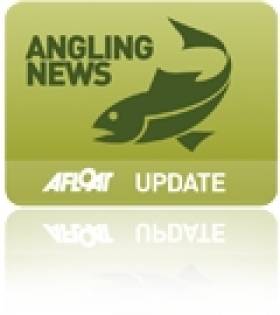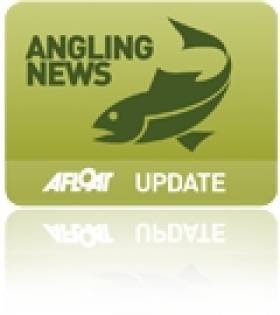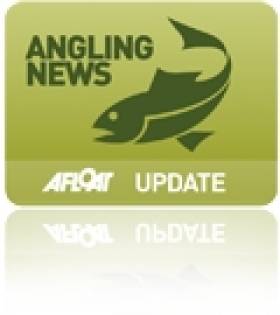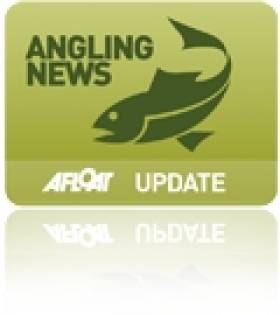Displaying items by tag: coarse angling
Inland Fisheries Ireland Reminds Anglers About Regulations Ahead of Busy Summer Season
July and August are typically the busiest months of the year for angling, so Inland Fisheries Ireland (IFI) is issuing a timely reminder about the national regulations that are in place to protect pike and coarse fish.
Angling is a hugely popular leisure activity and sport in Ireland, with IFI-commissioned research revealing that over 325,000 adults enjoy it.
According to an Amárach Research omnibus survey in 2021, 18% of adults who have not tried angling before are “likely” to try it in the future.
IFI is the State agency with responsibility for the promotion of angling, as well as the protection, conservation and management of inland fisheries and sea angling resources.
“Historically, Ireland has been known for its salmon and trout fishing, but the country is also being hailed internationally for its pike and coarse fishing,” IFI’s head of business development Suzanne Campion says.
“However, the national regulations around pike and coarse fishing might not be as well known.
“There are conservation measures in place to protect pike and coarse fish under national byelaws. It is very important that every angler, including first-time anglers and experienced anglers, becomes familiar with these pieces of legislation to avoid any potential fines or prosecutions.”
Pike are one of largest freshwater fish species in Ireland and can reach over 15kg (33lbs) in weight, while coarse fish include species such as roach, bream, rudd, tench and perch.
Important Bye Laws
Under the national Pike Bye Law (no. 809/2006), there’s a ‘bag limit’ of one pike in any one day. This means that an angler can only keep and take away one pike and must carefully return any other pike caught to the same waterbody, safely.
The same bye law also prohibits the killing of any pike that measure longer than 50 centimetres. In these cases, the pike must be returned, safely, to the same waterbody.
Under the Coarse Fish Bye Law (no. 806/2006), there’s a bag limit of four coarse fish in any one day, meaning that if an angler catches more than four course fish, those must be returned, safely, to the same waterbody. In addition, any coarse fish that measure longer than 25 centimetres cannot be killed.
Meanwhile, there are other regulations that apply to all anglers, regardless of what type of species they are fishing for. For example, it is illegal to fish in Ireland with more than two rods; it is illegal to transfer live roach from one waterbody to another and finally, the use of live bait when angling is prohibited.
Breaches of fisheries legislation could result in fixed penalty fines, seizure of fishing equipment or criminal prosecutions.
Catch and Release
‘Catch and release’ is a conservation practice that is supported by IFI, whereby a fish is handled responsibly and put back into the same waterbody, safely.
When fishing for coarse fish, the use of large keep nets is encouraged; it is also recommended that pike and carp sacks are used to weigh the fish, before returning them safely to the same waterbody.
Campion added: “For anyone interested in angling or trying it out, there is an extensive network of very active clubs, associations and federations all over the country that organise coaching, events and competitions. There’s also a dedicated website for angling in Ireland at www.fishinginireland.info with very helpful information about regulations and bye laws, directories and resources.”
Fears That Pandemic Has Dealt Fatal Blow to Fermoy Angling Festival
Fears are growing that Fermoy’s celebrated coarse angling festival may not take place again as the pandemic has hit key businesses in the East Cork town.
As the Irish Examiner reports, the Fermoy Coarse Angling Association called off two events on the River Blackwater last year due to COVID-related restrictions, as well as a third event this past May.
It’s now cancelled what would have been its calendar highlight next month, owing to a lack of tackle shops and suitable accommodation in the area, according to the club chairman.
Fermoy’s last remaining hotel closed recently, and there has been a reduction in the number of B&Bs to accommodate anglers from all over Ireland and the UK.
The growth of online shopping has also been blamed for the closure of the town’s tackle shops — with the nearest in Coachford more than 60km away.
The Irish Examiner has more on the story HERE.
Council Pours Cold Water On Carp Anglers’ Demands For Loughgall Lake
Plans by Armagh’s council to restock Loughgall Lake with £12,000 worth of carp have been deemed insufficient by local anglers.
According to ArmaghI, the Loughgall Carp Anglers group believes night angling catch rates would rise — and its membership would skyrocket — with a £50,000 investment in the Northern Ireland fishery.
But Armagh City, Banbridge and Craigavon Borough Council poured cold water on the suggestion as the funds are not available in the budget — while noting that Loughgall Lake is a mixed fishery intended to cater or all coarse angling enthusiasts.
It was also identified in a 2017 survey that the majority of fish were in the centre of the 37-acre lake, out of reach of shore anglers.
ArmaghI has much more on the story HERE.
Fish Kill Investigated At Carrigadrohid Reservoir
#FishKill - Inland Fisheries Ireland (IFI) and Cork County Council are investigating fish mortalities at Carrigadrohid Reservoir in Co Cork following the discovery of small numbers of bream and rudd.
As of 14 June no cause has been identified, but water and fish samples were being collected for further analysis at the popular coarse angling spot.
IFI has a 24-hour confidential hotline number to enable members of the public to report incidents at 1890 34 74 24 or 1890 FISH 24.
This phone line is designed to encourage the reporting of incidents of illegal fishing, water pollution and invasive species. For more information visit www.fisheriesireland.ie.
Cross-Border Duo Wins Angling World Pairs
#ANGLING - The cross-border team of Phil Jackson and Cathal Hughes took the top prize at the Lakelands & Inland Waterways World Pairs Angling Championship earlier this month, as The Irish Times reports.
The pair - from Craigavon and Galway respectively - received a cheque for more than €37,000 and a set of Daiwa tackle for their efforts in snagging a total catch of 117.560kg over the five days of fishing across the lakes and waterways of Monaghan, Leitrim. Cavan and Fermanagh - described as the world's richest coarse angling competition.
Close behind in the winners' table were the team of Derek Willan and Mark Pollard, whose 112.990kg total earned them second place and a cheque for more than €12,500.
"The fishing that has taken place over the last five days will be a significant turning point in how angling in Ireland is viewed all over the world," said Fáilte Ireland's Colm Breheny at the conclusion of the contest.
The Irish Times has more on the story HERE.
Survey to Assess Value of Irish Angling
#ANGLING - Inland Fisheries Ireland (IFI) has appointed Tourism Development International (TDI) to undertake a Socio-Economic Survey of Recreational Angling in Ireland.
The overall objective of the survey, which will run over the course of 2012, is to establish the current volume and value of domestic and overseas recreational angling in the country.
Pike, coarse fish, bass, salmon, sea trout, brown trout and sea anglers will all be invited to participate in what is described as Ireland's most comprehensive angling survey undertaken in decades.
The survey will inform IFI and its tourism partners in relation to the business of angling in Ireland and also enable improved strategic planning and decision-making in terms of product development and marketing.
"Anglers are the key to this survey," commented Minister of State for Natural Resources Fergus O'Dowd. "They know the resource and they understand the importance of sustainability. What anglers contribute to Ireland’s economy is unknown but I am certain that it is significant.
"Angling takes place in every river and lake in Ireland and all around our coastline. There is no town or village in Ireland that doesn’t have anglers."
He added: "It is imperative that the inland fisheries and sea angling resources are managed in the best way possible to ensure enjoyment for our local and visiting anglers, sustainable jobs in rural communities and maximising its potential to add to Ireland’s economy.
"Getting the right information from those most involved will greatly assist in improving the angling product."
The survey comprises two parts: a household survey and a survey of recreational anglers which will commence in April. Anglers will be met at fishing locations throughout Ireland and invited to participate there and then, or later by phone or online. IFI says that every effort will be made to accommodate participation.
- angling
- Inland Fisheries Ireland
- IFI
- Tourism Development International
- TDI
- survey
- SocioEconomic Survey of Recreational Angling in Ireland
- Pike
- Salmon
- Sea Trout
- brown trout
- coarse angling
- sea angling
- tourism
- business
- marketing
- development
- Minister of State for Natural Resources
- Fergus O'Dowd
- sustainability
- inland waterways
- jobs
Hooked Live! Returns to CityWest This Weekend
#ANGLING - Hooked Live!, Ireland’s premier angling and fishing show, is returning to the CityWest Hotel and Lakes this weekend 10-11 March for the third year running.
Spey caster and innovator Ian Gordon is the latest star to join the already confirmed visitor favorites Paul Young, Henry Gilbey, Scott MacKenzie, Andrew Ryan and AGPAI Ireland, who will bring world-class casting demonstrations, talks and personal one-to-one sessions designed to improve and empower visitors to become better anglers.
Bringing the best in Irish angling water sports, with new tackle, venues and angling techniques, Hooked Live! also caters for the fly-fishing enthusiast with fly-tying and casting lessons.
And that's not to mention fly-fishing on our fully stocked lake, where both trout and perch will readily take a fly. Indeed, there are many top prizes to be won in the Lakes Fishing Challenge.
Sea anglers are also catered for and welcome at Hooked Live! and for the coarse fisher, there will be top class exhibits with great tackle and equipment available and a range of venues which will produce results.
Popular seminars will also cover some of the new and successful tackle and techniques which are now being used to catch more fish.
Also returning to Hooked Live! will be the Sporting Gun Show. Taking advantage of the synergy between shooting and fishing, visitors will be able to pick up bargains on end-of-shooting-season stock.
Tickets for Hooked Live! 2012 are priced from just €10 and are available now from tickets.ie. For more details visit the official website at www.hooked.ie
New Angling Guide for Lough O'Flynn and Upper Suck
#INLAND WATERWAYS - Inland Fisheries Ireland (IFI) officially launched the Lough O’Flynn and Upper Suck Angling Guide at the Old Stonehouse Restaurant in Ballinlough recently.
The guide opens to Lough O'Flynn, a 300-acre limestone lake situated 2km from Ballinlough and one of IFI’s many managed lakes requiring a permit.
This lake holds a stock of wild brown trout and is also stocked with brown trout each year which provides an excellent opportunity for all kinds of anglers and those wishing to take up the sport to learn how to fish for trout.
Meanwhile, the centrefold of the guide showcases the Upper Suck catchment from Lough O’Flynn through Co Roscommon and Galway until the Shiven tributary joins, along which good quality coarse, pike and trout angling can be expected.
With breathtaking scenery, this is the perfect place for anglers who can fish almost undisturbed from dawn till dusk.
There are also a considerable number of sections dedicated to anglers with disabilities, such as the Donamon angling stretch which has 30 fishing stands available with individual car parking bays and toilet facilities. This section has proven extremely popular, and IFI says it is committed to ensuring that sections like Donamon continue to open fishing up for everyone.
Amanda Mooney, director at IFI, said: “The guide offers a great source of information on angling hotspots for various types of species, access points and facilities, legislation and safety.
"All in all everything you need for planning a fishing trip. The guide and angling promotion in general supports local businesses and communities in sustaining jobs.”
The Lough O’Flynn and Upper Suck Angling Guide is available from IFI outlets and local permit agents in Ballinlough, Co Roscommon.
Inland Fisheries Ireland also marked the retirement of John Ryan, assistant inspector for Lough O’Flynn and the Suck catchment, after 41 years of service.
Ryan was involved in many areas and aspects of fisheries throughout his career, and was particularly noted for his positive engagement with various groups from angling clubs and development associations to local authorities, businesses and communities.
Tributes Paid in Fermoy to Champion of Angling Jack O'Sullivan
#ANGLING - The Corkman has paid tribute to the late Jack O'Sullivan, one of the best known Irishmen in the coarse angling fraternity.
"He is a man who worked hard to put the town of Fermoy, and the stretches of the River Blackwater that enhance it, to the forefront of tourism," the paper writes.
"For 25 years he led from the front, not just by putting Fermoy on the map as a coarse angling destination but also his country, when he brought the likes of the World Coarse Angling Championships to Fermoy in 1968, and many other prestigious events down through the years."
A founder member of the National Coarse Fishing Federation of Ireland (NCFFI), in 2007 O'Sullivan received a gold medal from the organisation for his services to the Fermoy Coarse Angling Association, and angling tourism both local and national.
The Corkman has more on the story HERE.
Carlow CAC Receives Bursary for Disabled Angling Efforts
#ANGLING - Carlow Coarse Angling Club chair Gerry McStraw was presented last week with a special bursary by Carlow Sports Partnership for the club's efforts in helping disabled anglers to participate in the sport.
According to the Enniscorthy Guardian, McStraw was joined by Carlow CAC PR officer Ian Warburton and treasurer George Quinlan in receiving the money from Carlow Sports Partnership chair Tracey Byrne and Carlow County Council's Thomas Kinsella.
McStraw was recently highlighted on Afloat.ie for his spearheading of the revival of coarse fishing in Ireland.
The bursary will be used to buy equipment essential to running more coarse angling programmes in 2012.
Carlow CAC will also host three of the six weekends for the National Coarse Fishing Federation of Ireland's qualifiers next spring and summer.




































































